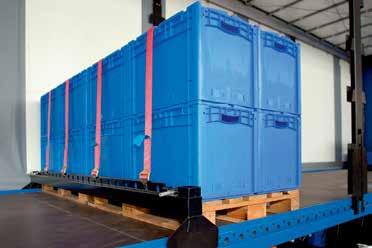
3 minute read
SAFETy MATTERS
Is your cargo safely secured?
Many people are injured every year as a result of unsecured or poorly secured loads on all trailer and body types. Every day incidents occur on roads and in yards because of cargoes that have not been properly stowed and/or secured. According to the European Commission Transportation Department: “It has been estimated that up to 25 percent of road incidents involving trucks can be attributable to inadequate cargo securing”. Cargo that is not properly secured can cause undesirable incidents, which may lead to lead to the loss of lives, the loss of vehicles, the loss of cargo, or cause environmental damage. Even if a road incident does not occur, think of the mess and hazards involved in unloading a cargo that has shifted during transit.
It’s easy to assume that a heavy load or a very light or small load either won’t move, or won’t cause a problem if it does, so it can seem like a waste of time and money to strap a load down for a short journey. The reality is that every load can and will move, no matter how carefully a journey is performed. Every piece of cargo must be restrained on the vehicle so that it cannot move on or off the vehicle. During transport, all cargo items should be prevented from sliding, tipping, rolling, wandering or undergoing substantial deformation and rotation in any direction by methods such as locking, blocking (local/overall), direct lashing and top-over lashing, or combinations of these methods. This is to protect the people involved in loading, unloading and driving the vehicle, together with other road users, pedestrians, the load itself and the vehicle. All parties involved in the logistics process, including packers, loaders, transport companies, operators and drivers, have a role to play in ensuring that cargo is properly packed, loaded and secured on a suitable vehicle.
On 20 May 2018, the provisions of Directive 2014/47/EU (on the technical roadside inspection of the roadworthiness of commercial vehicles) relating to the inspection of cargo securing became law. This now means that during a roadside inspection a vehicle may be subject to an inspection of its cargo securing in accordance with Annex III of this Directive, in order to ensure that the cargo is secured in such a way that it does not interfere with safe driving, or pose a threat to life, health, property or the environment. Checks may be carried out to verify that during all kinds of operation of the vehicle, including emergency situations or uphill starting manoeuvres loads can only minimally change their position relative to each other, against walls or surfaces of the vehicle, and loads cannot leave the cargo space or move outside the loading surface. Annex III of the directive also refers to European Standards regarding, among other things, the calculation of lashing forces (EN 12195-1), the strength of lashing points and vehicle body structure EN 12640, EN 12642) as well as the strength of lashing slings, chains and steel wire ropes (EN 12195-2, EN 12195-3, EN 12195-4).
If involved in any aspect of the transporting of cargo by road now is a good time to “up your game” where it comes to the securing of that cargo. A good place to start is to refer to resources available on the HSA website dedicated to load securing, www.loadsafe.ie. 1. “European Best Practice Guidelines on Cargo Securing for Road Transport”, published by the European Commission, are intended to support the application of rules as laid down in Directive 2014/47/EU. These guidelines provide physical and technical background information as well as practical advice and instructions to all persons involved in loading/unloading and securing cargo on vehicles, including carriers and shippers. 2. “International Guidelines on Safe Load Securing for Road Transport”, published by the IRU, provide clear practical information on how to achieve safe load securing practices in the workplace, and provide basic practical information and instruction to all persons in the transport chain involved in loading/unloading and securing load on vehicles. 3. Also available is a series of information sheets, developed jointly by An Garda Síochána, the Road Safety Authority and the Health & Safety Authority, dealing with specific load types such as Curtain-sided trailers, Plant and Machinery, Round Timber, Pre-cast Concrete, Structural Steel and Site Cabins.










